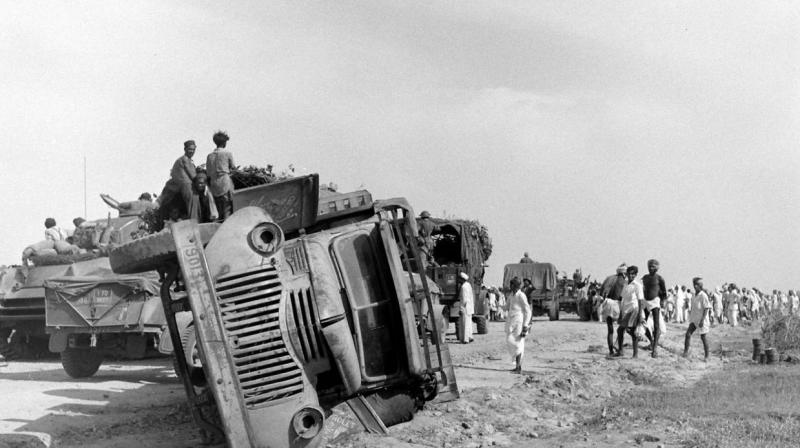Hyderabad’s tryst with history
On ‘Liberation Day’, we look at what drives the political discourse vis-a-vis the Nizam and his rule.

Come September, calls for Hyderabad Liberation Day to be officially celebrated start echoing across Telangana every year, and it appears that they are growing shriller by the year.
The very fact that a certain section, 71 years after the events of that fateful day, is still trying to convince the people that Mir Osman Ali Khan was indeed bad news for the people of Hyderabad state, speaks volumes.
What also speaks volumes is the fact that history is a very political subject and religion, though covertly, plays its part in defining history. History can best be described as a legacy of the victor.
The question now is whether is it this “victor” that is defining the political discourse vis-a-vis the Nizam and his rule?
Was the Nizam indeed bad news for the state as is being propagated?
By September 1948, Hyderabad was the most prosperous and well governed princely state of pre Independence India.
At the time other princely states in British India were struggling, to say so politely, Hyderabad had amenities like a well functioning transport system in place with its own railways, airways and roadways, thermal power station supplying electricity, telephones, a world-class university apart from schools and colleges for children of all ages, hospitals, maternity homes, TB sanatoriums, quarantine facilities, posts and telegraphs, its own currency, piped water supply and of course, an underground sewerage system no other princely state in the subcontinent had at that time.
It also was an industrial powerhouse, producing textiles, ceramics, glass, cement, sugar, cigarettes, matchboxes, herbal medicine and soaps and many more. Agriculture fetched handsome rewards; there are no recorded instance of farmer suicide due to debt in the Nizam’s Dominions.
The irrigation system was the most advanced in the subcontinent, helping agriculturists thrive.
Education was free and for everyone; class, creed or colour did not matter.
Certain sections, every September, go to town vilifying the Nizam and blame him for the atrocities committed by the various types of Razakars.
They try to portray in the Indian Army’s march, without saying this in so many words, into the Nizam’s Dominions as a battle between the “oppressed Hindus and the tyrant Razakars”.
These sections are doing a great disservice to the people; they tend to mask the fact that history is what made the world what it is today and unless we understand and accept our foundation, we never know whether it is strong enough to sustain us.
These sections position Police Action as a Hindu versus Muslim battle, but this is a very simplistic view.
The Nizam, and all his predecessors was perhaps the most secular of leaders in South India, if not in the subcontinent.
How else would one explain the fact he sanctioned a mammoth Rs 30 lakh for restoration of the Ajanta Ellora heritage sites?
One may argue that his reported donation of 5,000 kg gold to the Government of India during the 1965 war with Pakistan remains the single largest donation ever by an individual for a national cause, was after Police Action.
However, one cannot ignore his generous grants and donations to educational and research bodies like the Benaras Hindu University, Bhandarkar Institute Pune (for research on Mahabharata), Andhra University, schools named after Shivaji, for protection of temples of Anantgiri, Balaji and many others, establishing the Telugu Academy and publication of books on ancient Hindu monuments are to name just a few.
While Hindu subjects were allowed six month’s leave and advance pay for their Char Dham yatras, Muslims were allowed to go on Haj.
The spontaneous outbreak of public sorrow as the news of his death in 1967, with over 10 lakh people across religious and social barriers attending the funeral, is testimony to his popularity.
The one year, one month and one day period between August 15, 1947 and September 17, 1948, was the only period in its history that Hyderabad State was truly independent.
While the Asaf Jahis were the rulers of the Deccan, they themselves accepted the suzerainty of the Mughals, and after the decline of the Mughal Empire, the British were the de facto rulers of the state.
The question now is: What exactly happened on September 17, 1948?
The only thing that happened on that day was a radio broadcast by Nawab Mir Osman Ali Khan, Asaf Jah VII, ordering his forces to cease fire.
This message allowed the Indian Army to take possession of the Secunderabad Cantonment, till then under British Control.
The Nizam’s radio broadcast meant the lifting of the house arrest of Government of India’s Agent General K.M. Munshi, allowing him to work on a new government, with the Nizam as Head of State.
The Nizam also took the opportunity to do something that he undoubtedly wanted to do for some time — declare the Razakars as an unlawful body.
It was on the following day, on September 18, 1948 that Maj. General J.N. Choudhry, the Military Governor, entered Hyderabad.
